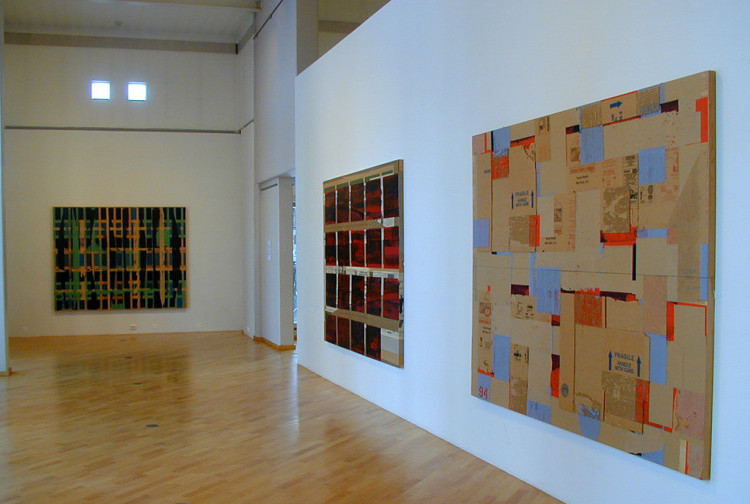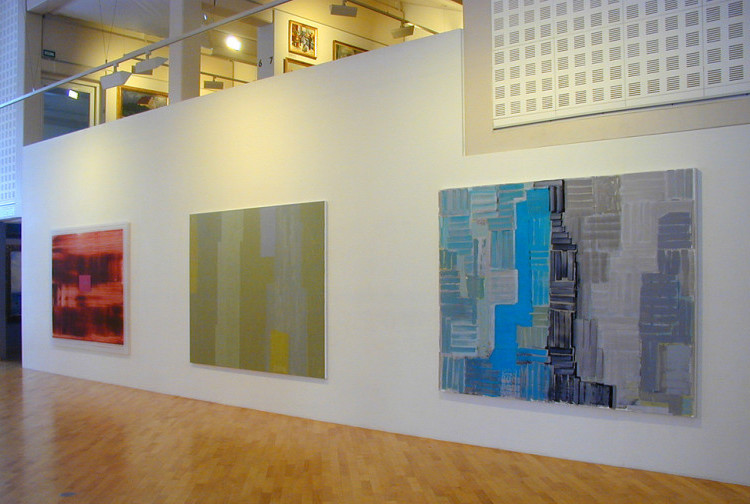Sverre Wyller - The Paterson Project
The Paterson Project is a large landscaped work of art consisting of 10 large paintings. Sverre Wyller (b. 1953) began working with them in 1992 and it took ten years to complete the work. This is because the artist decided to create a work that involved a commitment and patience. When he planned the series, he set up a set of rules that would guide the work. He was to make one Paterson picture towards the end of each of the following 9 years and they were all to have the same format, determined by the maximum dimensions of the elevator in his then studio building in the Tribeca district of New York.
The title of the project is taken from the American poet William Carlos Williams' poem Paterson, a five-part poem of 236 pages, and which took the author 12 years to write (1946-58). This with a long, binding program was what fascinated Wyller about Williams' poems. And although the paintings are not illustrations of themes in the poem Paterson, it is a structural kinship. Both works have a local roots in the life and local environment of poets and painters. For Wyller, the framework around life during these ten years has changed, from New York City to the small town of Red Hook in Upstate New York and back to his hometown Oslo. There is a difference in that someone who uses words can address local historical issues and theoretical issues, while a painter must adhere to sensory means, such as color, line and space and art historical symbols and styles. But there are also parallels: for where the poet alternates between different linguistic levels and literary styles, such as alternating between everyday speech and advanced modernist free forms, Sverre Wyller's series of images is a dialogue with modernism's diverse supply of figures and forms.
These are three main themes in Wyller's photo series; it is the use of different materials and various techniques; it is the work of creating shallow, modern and dynamic picture spaces and it is the traces of the autobiography. The autobiographical here is never too private. But it has to do both with his memory of his homeland and homeland, the influence of American life and with the impulses he received purely artistically in encounters with the famous American late-modernism and the magnificent museums' exhibitions and collections. We also get certain tips by looking at company marks on the cardboard boxes, from the place he left to go home. The moving boxes were reused as art!
The very special thing about this project is that it shows the time through the change that took place in Sverre Wyller's art in the ten years from 1992 to 2001. We see that he initially had the straight wooden shapes from the time in Norway and Germany (he lived in Berlin for several years in the 1980s). After he came to America, the significance of the modernist grid (The Grid) became actualized, since it is both important for late-modern American visual art (Ad Reinhardt, Ellsworth Kelly, Agnes Martin), but also something that is very clear in the checkered the street structure in Manhattan and as a pattern you can read in the huge skyscraper facades, where windows, crossbeams and pillars form one grid after another. This motif had already occupied Wyller in connection with window bars. And he regained contact with what he had been working on when he paraphrased the grid patterns of the Dutch abstract master Piet Mondrian (1872-1944).
American everyday life and the most widespread thought traditions "over there" - Pragmatism - place great emphasis on accepting things as they are, by understanding things as they appear and having a great sense of and respect for the material and physical, the given, the ordinary, and not trying to hide traces of work and tools. This inaccuracy and unpretentious attitude is seen in Wyller's use of plywood boards, newsprint, corrugated cardboard, old moving boxes, paper tape and the building material akyver, which are transparent sheets of duct plastic. These materials have the advantage that they are contemporary and seem relevant, they age together with painters and spectators and they are very well suited to work with the abstract language of abstract painting, which is about building spatial conditions that are optical, show evenly distributed patterns. and is without visual gaps and without a central perspective. We see that the methods, collage and de-collage (tear-off), the use of a stencil and a trowel knife fit very well with the type of shapes he creates. That the choice of akyver also makes it possible to paint on both sides of the plate, the gain is achieved that the shallow and flat modern picture space also becomes something purely physical, like a narrow layer of really spatial distance. It is this physical presence of paint and process that makes it important that these paintings are so large. They should give a sense of direct relationship between the painter's materials, tools and movements and the viewer. This creates a kind of frontality in the images. It is such considerations that form the basis for the New York school's masters in the post-war period - Pollock, Newman, Rothko, Guston and de Kooning - and now Wyller - to paint such large pictures.
Sverre Wyller is interested in painting as a process he and the audience can grow with and age through. He has therefore also made a series of 12 paintings, one for each of the months of the year. In relation to this, Paterson also becomes a calendar or an old almanac, which goes over ten years and brings with it marks and traces from the picturesque life Sverre Wyller has led during this period. The differences and breaks, as well as the continuities we can see in the paintings, are authentic witnesses to what has happened. This he could not have decided to anticipate and get the time lapse in advance and made them all at once and hid them for 10 years. Nor could he have waited for 10 years and then tried to reconstruct the course, as art historians are referred to work. No, this is the story painted in real time, and therefore it is possible for the audience to see that he long stuck to square squares and few, strong colors and the material akyver, while in periods he has worked with cardboard and paper, for then in the last pictures to go over to paint with tempera on canvas strung up on blind frame. Both ancient (tempera) and new (acrylic) materials are used. We also now see a return to a simpler method of production, but the problem, the creation of rhythm, life and harmony along the surface, is still something that occupies the artist in the last picture.
Here the expression has a more hand-painted feel, with straight, rhythmic and staccato brushstrokes, full of the vitality that both Mondrian (1940) and Wyller (1987) met when they chose to settle in the metropolis that never sleeps, which has been sung for his hectic rhythm, pulsating light - and his Broadway Boogie Woogie, as this visual pulse is also called.
The exhibition is accompanied by a book, in which the American professor and Williams expert Christopher MacGowan and Åsmund Thorkildsen have written about Willam Carlos Willams 'and Sverre Wyllers' PATERSON, respectively.
Åsmund Thorkildsen
Museum director



